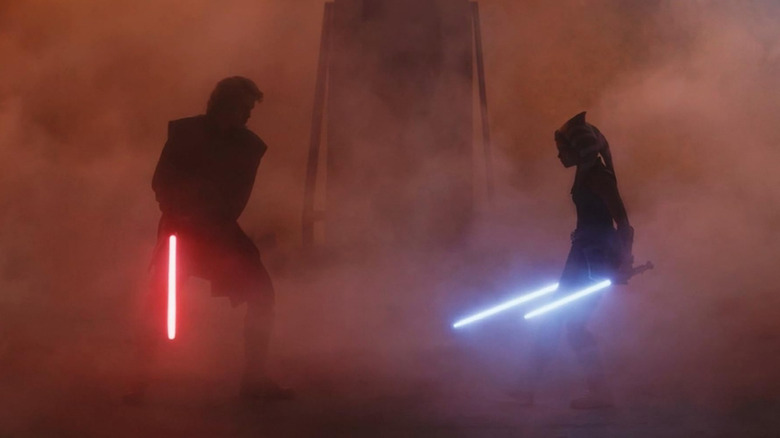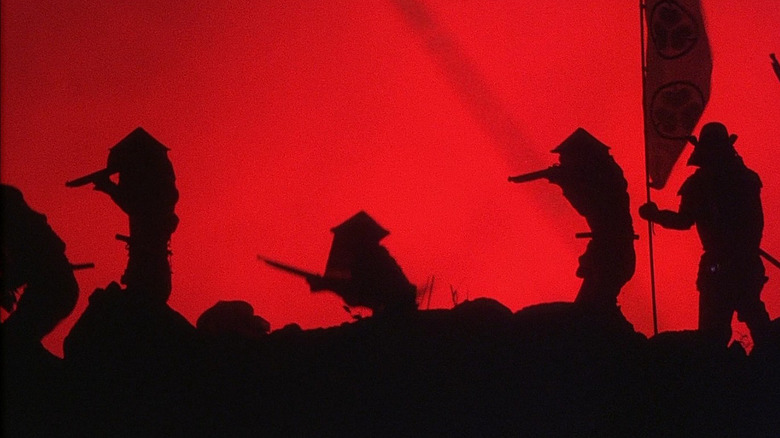How An Unexpected Akira Kurosawa Classic Influenced Ahsoka
There would be no "Star Wars" without Akira Kurosawa. The fabled Japanese filmmaker was a massive influence on creator George Lucas and his vision for a galaxy far, far away, with his period adventures "Seven Samurai" and especially "The Hidden Fortress" informing so much of the Jedi's aesthetics and philosophy, as well as the plot and characters of "A New Hope." Creatives on more recent "Star Wars" projects have only continued to mine inspiration from Kurosawa's oeuvre, with Rian Johnson drawing pretty explicitly from the director's classic "Rashomon" for the perspective-shifting flashbacks to Luke Skywalker's confrontation with his nephew Ben Solo in "The Last Jedi."
For "Ahsoka," a spinoff of "The Mandalorian" and live-action sequel to his animated series "Star Wars Rebels," creator Dave Filoni — who's since been promoted to chief creative officer of Lucasfilm — looked to another Kurosawa film entirely for the show's most fantastical outing yet. During season 1, episode 5, titled "Shadow Warrior," the titular ex-Jedi Ahsoka Tano (Rosario Dawson) seemingly finds herself in the World Between Worlds, a mythical plane beyond the physical world and the Netherworld of the Force. Upon coming face-to-face with the specter of her old mentor, Anakin Skywalker (Hayden Christensen), Ahsoka suddenly begins tumbling through memories of her experiences fighting alongside Anakin as a teenager during the Clone Wars.
As much as Ahsoka's (quite literally) foggy memories bring to mind the foggy forest and hills from Kurosawa's "Macbeth"-inspired "Throne of Blood," it was actually the filmmaker's 1980 historical epic "Kagemusha" that Filoni (who both wrote and directed "Shadow Warrior") and the episode's cinematographer, Quyen Tran, used as a point of reference. "That called for a lot of color and was dreamy and something new in look," Tran explained, speaking to the International Cinematographers Guild Magazine for its January 2024 edition.
Star Wars gets abstract
With its heavy use of silhouettes during the moments where Ahsoka is reliving her past, you can readily spot the visual parallels between "Shadow Warrior" and the combat sequences from "Kagemusha" (see the above image). According to Tran, she and Filoni strove for "heavy saturation and silhouettes" in these scenes, with Filoni telling ICGM that he particularly wanted to evoke the "color and surrealism" of the nighttime battle in Kurosawa's film. Filoni explained his reasoning as follows:
"The silhouettes of the clones moving in a fog of memory. Q and I got together with the previz team and we staged [all of episode 5] together so it was all realized before we ever got to the stage. We both felt that because it was such an abstract episode, we wanted to be certain of the images and their impact when we went to capture them."
One may notice "Kagemusha" makes use of unnaturally — but strikingly — bold colors during its action scenes, as opposed to the comparatively realistic shades used in "Shadow Warrior." In point of fact, most of "Ahsoka" is relatively visually grounded, even when depicting wondrous planets and locations like the World Between Worlds. It's a creative choice more than anything, though it's also one of the many reasons why "Star Wars" animation enthusiasts like myself wish that "Ahsoka" had been an animated show rather than live-action (given that Filoni has typically been willing to utilize bolder and more pleasing colors in animation). Be that as it may, "Shadows Warrior" certainly boasts its fair share of eye-catching imagery. As is so frequently the case with "Star Wars," you can thank Akira Kurosawa for that.
"Ahsoka" season 1 is now streaming on Disney+, with season 2 currently in active development.

